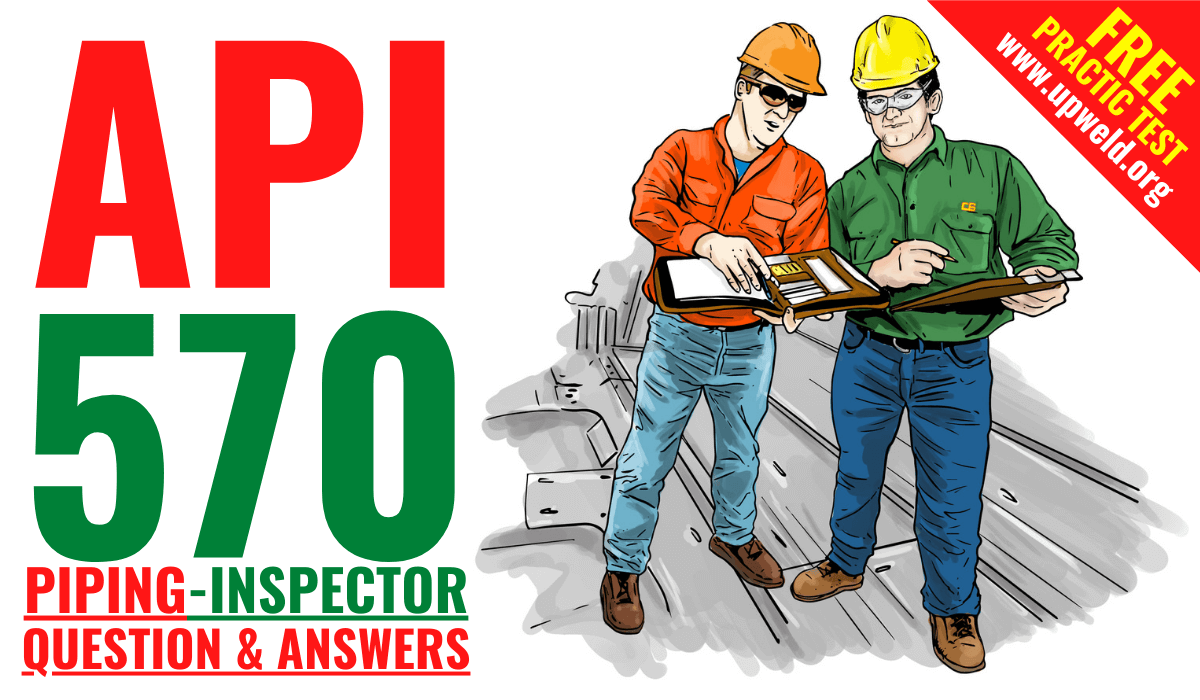Take A FREE Online Piping Inspector API 570 Practice Test Or Exam Training Course
Contact us to Buy Study Material UpWeld.Org@Gmail.Com 99% Passing Guarantee
*************************

Are you looking for a Free Online Piping Inspector API 570 Practice Test or Training Course?
If yes Then you are on the right platform, Here You Can Learn everything you need to know about Piping Inspector API 570 Exam
Pass the API 570 Certification Exam on the first time attempt. Our expert-written API practice material covers the actual exam topics with fully explained answers.
Take unlimited tests of any length. Includes free new question updates and complements any other study materials.
Read More Free Questions related API 570 Exam:
- Top 21 Latest API 570 Exam Questions and Answers – ALL QUESTIONS ARE OPEN BOOK
- Top Most Important 93 Latest API 570 Exam Questions and Answers
- Top 146 Latest Piping Inspector API 570 Questions and Answers
- Top 115 Latest API 570 Exam Questions and Answers – ALL QUESTIONS ARE CLOSE BOOK
- Top 41 Latest API 570 Exam Questions and Answers – ALL QUESTIONS ARE CLOSE BOOK
- Top 99 Latest Piping Inspector API 570 Practice Questions and Answers Free Test (Closed Book)
- Top 181 Latest API 570 Practice Questions and Answers (Closed Book)
Buy API 570 Exam Learning Package Study Material
FOR EVERY 10 QUESTIONS 1 QUESTION COMES IN THE EXAM
WE HAVE LATEST API 570 Exam QUESTION BANK
99% Passing Guarantee
Total 5000+ nos QUESTION BANK FROM THEORY TO PRACTICAL.
Cost: $100
Email Us To Buy: upweld.org@gmail.com
Click Here To Contact On WhatsApp https://wa.link/4dn6ee
Ideally, a document for passing the examination. Free guidelines during learning.
We give you lots of study material Free of cost with this question bank.
Get BOTH Formats Instantly:
Online—Instant scoring, review & reporting.
Printable—Instant download.
The API Individual Certification Programs (ICPs) are well-established worldwide in the oil, gas, and petroleum industries. This Quick Guide is unique in providing simple, accessible, and well-structured guidance for anyone studying the API 570 Certified Pipework Inspector syllabus by:
Piping Inspector API 570 Practice Test or Exam Training Course Content:
- Summarising and helping them through the syllabus
- Providing multiple example questions and worked answers
- Technical standards covered include the full API ‘body of knowledge for the examination
- API 570 Piping inspection code
- API RP 571 Damage mechanisms affecting fixed equipment in the refining industry
- API RP 574 Inspection practices for piping system components
- API RP 577 Welding and metallurgy
- API RP 578 Material verification program for new and existing alloy piping systems
- ASME V Non-destructive examination
- ASME IX Welding qualifications; ASME B16.5 Pipe flanges and flanged fittings
- ASME B 31.3 Process piping
- Provides simple, accessible and well-structured guidance for anyone studying the API 570 Certified Pipework
- Inspector syllabus
- Summarizes the syllabus and provides the user with multiple example questions and worked answers
- Technical standards covered include the full API ‘body of knowledge for the examination
Take the free practice test quiz course and improve your knowledge:
- API 571 Quiz
- API 574 Quiz
- API 577 Quiz
- API 578 Quiz
- ASME Section V Quiz
- ASME Section IX Quiz
- ASME B16.5 Quiz
- ASME B 31.3 Quiz
This API 570 quiz Course presents multiple-choice questions. You are to assume there is ONLY ONE CORRECT ANSWER. There are lots of questions.
Request To Buy Study Material at UpWeld.org@Gmail.Com
People also ask:
- How hard is the API 570 exam?
- How much do API 570 inspectors make?
- How much does API 570 cost?
- What does an API 570 inspector do?
- What is the API 570?
- Is API 570 exam hard?
- What is the passing score for API 570?
- Are API 570 inspectors in demand?
Related searches
- API 570 PRACTICE QUESTIONS AND ANSWERS (Closed Book)
- BASIC PIPING INSPECTION TERMINOLOGY & RP 574 Practice Questions and Answers
- ASME B 31.3 — PRACTICE QUESTIONS AND ANSWERS (CLOSED BOOK
- ASME V PRACTICES QUESTIONS AND ANSWERS
- API 510, API 574, ASME B31.3, ASME B16.5(a), ASME Section V or ASME Section IX
- API 570 Piping Inspector Examination Preparation Course
- Online API 570 Training Course
- API 570 Piping Inspector Certification
- API 570 Process Pipework Inspector Certification Training
- UpWeld API 570 Training Course: Pressure Piping Inspection
- API 570 Piping Inspector Full Course
- API 570 Exam Preparation – API 570 Training
- API 570 – Piping Inspector
- api 570 download
- api 570 pdf
- api 570 fees
- api 570 standard pdf free download
- api 570 salary
- api 570 4th edition pdf
- api 570 code
- api 570 course
- api 570 training
- api 570 training course
- api 570 training online
- api 570 course fee
- api 570 exam pass rate
- api 570 exam questions
- api 570 study material
- api 570 pdf free download